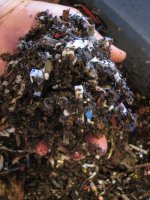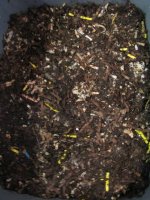Hey everyone, this is my second attempt at a worm bin and I keep running into the same problem it seems.
Im currently using two 18 gallon rubbermaids stacked. I start out with a lb of worms and shred newspaper and cardboard for the bedding, then I add some food items.. your typical vegetable scraps and so on and so on for awhile. After a few months of feeding the bed the bedding is noticeably broken down. At that point I make up the second bin with fresh bedding and food and proceed to feed it for a little while.
Up until this point everything seems to chug along just fine, the worms noticeably increase in population and I see cocoons everywhere. The idea of course is that the worms will move up into the second bin and I can harvest the bottom bin.
Well something goes wrong along the way because what I end up with is TWO bins that are like 70-80% completed. The worms never actually "finish" anything up. In an attempt to get them to eat the residual bedding and food items I stop feeding.
This is what I end up with, and I notice the worm population dwindles. Obviously I need to add fresh bedding and food... but if I do that they wont finish the lower bins.
This has happened twice now. Both times, with new bins and new worms... they complete the bottom bin to about 70%, so I add the second bin... they complete the second bin to about 70-80% or so and then the populations start to die off (or so it seems).
Whats the deal? I ordered a new 7 tray worm factory it should be here in a few days. Im hoping this will help me get the hang of things better. Im wondering if Im simply using bins that are too big with to small of a worm population. Also, the compost is probably 14-15" deep in each bin... very deep. Not only that but the bins get extremely heavy and the unfinished castings and up very compacted. The worm factories trays are much shallower so should help in that respect.
Suggestions?


Im currently using two 18 gallon rubbermaids stacked. I start out with a lb of worms and shred newspaper and cardboard for the bedding, then I add some food items.. your typical vegetable scraps and so on and so on for awhile. After a few months of feeding the bed the bedding is noticeably broken down. At that point I make up the second bin with fresh bedding and food and proceed to feed it for a little while.
Up until this point everything seems to chug along just fine, the worms noticeably increase in population and I see cocoons everywhere. The idea of course is that the worms will move up into the second bin and I can harvest the bottom bin.
Well something goes wrong along the way because what I end up with is TWO bins that are like 70-80% completed. The worms never actually "finish" anything up. In an attempt to get them to eat the residual bedding and food items I stop feeding.
This is what I end up with, and I notice the worm population dwindles. Obviously I need to add fresh bedding and food... but if I do that they wont finish the lower bins.
This has happened twice now. Both times, with new bins and new worms... they complete the bottom bin to about 70%, so I add the second bin... they complete the second bin to about 70-80% or so and then the populations start to die off (or so it seems).
Whats the deal? I ordered a new 7 tray worm factory it should be here in a few days. Im hoping this will help me get the hang of things better. Im wondering if Im simply using bins that are too big with to small of a worm population. Also, the compost is probably 14-15" deep in each bin... very deep. Not only that but the bins get extremely heavy and the unfinished castings and up very compacted. The worm factories trays are much shallower so should help in that respect.
Suggestions?




